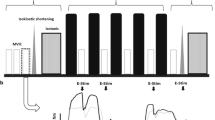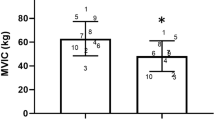Abstract
A sustained voluntary contraction increases central fatigue and produces a ‘cross-over’ of fatigue during a subsequent contraction of the contralateral limb. These studies compared the magnitude of these changes for men and women. Force and electromyographic responses from dominant (study 1; n = 8 men, 8 women) or non-dominant (study 2; n = 7 men, 8 women) leg extensors to nerve stimulation were recorded at rest and during brief maximal voluntary contractions (MVCs), before and after 100-s sustained MVCs performed with the dominant leg. For the dominant leg, force was reduced more for men (by ∼24%) than women (by ∼16%, P < 0.05) after the sustained contractions. Similarly, voluntary activation during these contractions was reduced more for men (by ∼22%) than women (by ∼9%, P < 0.05). Conversely, resting twitches changed similarly for both sexes (P > 0.05). For the non-dominant leg, men experienced a reduction in force (by ∼13%, P < 0.001) and had greater deficits in activation than women (∼9% vs ∼3%, P < 0.05), after sustained contractions of the dominant leg. Therefore, sustained MVCs produce greater central fatigue and a more pronounced ‘cross-over’ of effects to the contralateral limb for men compared to women. These findings demonstrate distinct differences between sexes in the way the nervous system adapts to changes associated with fatigue.






Similar content being viewed by others
References
Albert W, Wrigley A, McLean R, Sleivert G (2006) Sex differences in the rate of fatigue development and recovery. Dyn Med 5:2
Aranyi Z, Rosler KM (2002) Effort-induced mirror movements. A study of transcallosal inhibition in humans. Exp Brain Res 145:76–82
Arya T, Bajwa S, Edgley SA (1991) Crossed reflex actions from group II muscle afferents in the lumbar spinal cord of the anaesthetized cat. J Physiol 444:117–131
Baker AJ, Brandes R, Weiner H (1995) Effects if intracellular acidosis on Ca2+ activation, contraction, and relaxation of frog skeletal muscle. Am J Physiol Cell Physiol 268:C55–C63
Barnes WS (1980) The relationship between maximum isometric strength and intramuscular circulatory occlusion. Ergonomics 23:351–357
Baumer T, Munchau A, Weiller C, Liepert J (2002) Fatigue suppresses ipsilateral intracortical facilitation. Exp Brain Res 146:467–473
Baxendale RH, Rosenberg JR (1976) Crossed reflexes evoked by selective activation of muscle spindle primary endings in the decerebrate cat. Brain Res 115:324–327
Baxendale RH, Rosenberg JR (1977) Crossed reflexes evoked by selective activation of tendon organ afferent axons in the decerebrate cat. Brain Res 127:323–326
Bigland-Ritchie B, Johansson R, Lippold OC, Woods JJ (1983) Contractile speed and EMG changes during fatigue of sustained maximal voluntary contractions. J Neurophysiol 50:313–324
Brooke JD, Cheng J, Collins DF, McIlroy WE, Misiaszek JE, Staines WR (1997) Sensori-sensory afferent conditioning with leg movement: gain control in spinal reflex and ascending paths. Prog Neurobiol 51:393–421
Butler JE, Taylor JL, Gandevia SC (2003) Responses of human motoneurons to corticospinal stimulation during maximal voluntary contractions and ischemia. J Neurosci 23:10224–10230
Cernacek J (1961) Contralateral motor irradiation-cerebral dominance. Its changes in hemiparesis. Arch Neurol 4:165–172
Clark BC, Collier SR, Manini TM, Ploutz-Snyder LL (2005) Sex differences in muscle fatigability and activation patterns of the human quadriceps femoris. Eur J Appl Physiol 94:196–206
Clark BC, Manini TM, The DJ, Doldo NA, Ploutz-Snyder LL (2003) Gender differences in skeletal muscle fatigability are related to contraction type and EMG spectral compression. J Appl Physiol 94:2263–2272
Cram JR, Kasman GS (1998) Introduction to surface electromyography. Aspen, Gaithersburg, ML
Ditor DS, Hicks AL (2000) The effect of age and gender on the relative fatigability of the human adductor pollicis muscle. Can J Physiol Pharmacol 78:781–790
Ettinger SM, Silber DH, Collins BG, Gray KS, Sutliff G, Whisler SK, McClain JM, Smith MB, Yang QX, Sinoway LI (1996) Influences of gender on sympathetic nerve responses to static exercise. J Appl Physiol 80:245–251
Farina D, Merletti R, Enoka RM (2004) The extraction of neural strategies from the surface EMG. J Appl Physiol 96:1486–1495
Ferbert A, Priori A, Rothwell JC, Day BL, Colebatch JG, Marsden CD (1992) Interhemispheric inhibition of the human motor cortex. J Physiol 453:525–546
Fulco CS, Rock PB, Muza SR, Lammi E, Cymerman A, Butterfield G, Moore LG, Braun B, Lewis SF (1999) Slower fatigue and faster recovery of the adductor pollicis muscle in women matched for strength with men. Acta Physiol Scand 167:233–239
Gandevia SC (2001) Spinal and supraspinal factors in human muscle fatigue. Physiol Rev 81:1725–1789
Gandevia SC, Allen GM, Butler JE, Taylor JL (1996) Supraspinal factors in human muscle fatigue: evidence for suboptimal output from the motor cortex. J Physiol 490:529–536
Gandevia SC, Petersen N, Butler JE, Taylor JL (1999) Impaired response of human motoneurones to corticospinal stimulation after voluntary exercise. J Physiol 521:749–759
Garland SJ (1991) Role of small diameter afferents in reflex inhibition during human muscle fatigue. J Physiol 435:547–558
Graham R, Jammes Y, Delpierre S, Grimaud C, Roussos C (1986) The effects of ischemia, lactic acid and hypertonic sodium chloride on phrenic afferent discharge during spontaneous diaphragmatic contraction. Neurosci Lett 67:257–262
Harrison PJ, Zytnicki D (1984) Crossed actions of group I muscle afferents in the cat. J Physiol 356:263–273
Hicks AL, Kent-Braun J, Ditor DS (2001) Sex differences in human skeletal muscle fatigue. Exerc Sport Sci Rev 29:109–112
Hicks AL, McCartney N (1996) Gender differences in isometric contractile properties and fatigability in elderly human muscle. Can J Appl Physiol 21:441–454
Hortobagyi T, Taylor JL, Petersen NT, Russell G, Gandevia SC (2003) Changes in segmental and motor cortical output with contralateral muscle contractions and altered sensory inputs in humans. J Neurophysiol 90:2451–2459
Hunter SK, Butler JE, Todd G, Gandevia SC, Taylor JL (2006) Supraspinal fatigue does not explain the sex difference in muscle fatigue of maximal contractions. J Appl Physiol 101:1036–1044
Hunter SK, Critchlow A, Shin IS, Enoka RM (2004) Fatigability of the elbow flexor muscles for a sustained submaximal contraction is similar in men and women matched for strength. J Appl Physiol 96:195–202
Hunter SK, Critchlow A, Shin IS, Enoka RM (2004) Men are more fatigable than strength-matched women when performing intermittent submaximal contractions. J Appl Physiol 96:2125–2132
Hunter SK, Enoka RM (2001) Sex differences in the fatigability of arm muscles depends on absolute force during isometric contractions. J Appl Physiol 91:2686–2694
Jankowska E (1992) Interneuronal relay in spinal pathways from proprioceptors. Prog Neurobiol 38:335–378
Kagaya A, Homma S (1997) Brachial arterial blood flow during static handgrip exercise of short duration at varying intensities studied by a Doppler ultrasound method. Acta Physiol Scand 160:257–265
Kaufman MP, Forster HV (1996) Reflexes controlling circulatory, ventilatory and airway responses to exercise. Handbook of physiology exercise: regulation and integration of multiple systems. Am Physiol Soc, Bethesda, MD, pp 381–447
Kernell D, Monster AW (1982) Motoneurone properties and motor fatigue. An intracellular study of gastrocnemius motoneurones of the cat. Exp Brain Res 46:197–204
Kernell D, Monster AW (1982) Time course and properties of late adaptation in spinal motoneurones of the cat. Exp Brain Res 46:191–196
Lamb GD, Recupero E, Stephenson DG (1992) Effect of myoplasmic pH on excitation–contraction coupling in skeletal muscle fibres of the toad. J Physiol 448:211–224
Lamb GD, Stephenson DG (2006) Point: lactic acid accumulation is an advantage during muscle activity. J Appl Physiol 100:1410–1412 (discussion 1414)
Macefield G, Hagbarth KE, Gorman R, Gandevia SC, Burke D (1991) Decline in spindle support to alpha-motoneurones during sustained voluntary contractions. J Physiol 440:497–512
Martin PG, Smith JL, Butler JE, Gandevia SC, Taylor JL (2006) Fatigue-sensitive afferents inhibit extensor but not flexor motoneurons in humans. J Neurosci 26:4796–4802
Maughan RJ, Harmon M, Leiper JB, Sale D, Delman A (1986) Endurance capacity of untrained males and females in isometric and dynamic muscular contractions. Eur J Appl Physiol Occup Physiol 55:395–400
Meyer BU, Roricht S, Grafin von Einsiedel H, Kruggel F, Weindl A (1995) Inhibitory and excitatory interhemispheric transfers between motor cortical areas in normal humans and patients with abnormalities of the corpus callosum. Brain 118:429–440
Nielsen OB, de Paoli F, Overgaard K (2001) Protective effects of lactic acid on force production in rat skeletal muscle. J Physiol 536:161–166
Pedersen TH, de Paoli F, Nielsen OB (2005) Increased excitability of acidified skeletal muscle: role of chloride conductance. J Gen Physiol 125:237–246
Pedersen TH, Nielsen OB, Lamb GD, Stephenson DG (2004) Intracellular acidosis enhances the excitability of working muscle. Science 305:1144–1147
Posterino GS, Dutka TL, Lamb GD (2001) l(+)−lactate does not affect twitch and tetanic responses in mechanically skinned mammalian muscle fibres. Pflugers Arch 442:197–203
Rattey J, Martin PG, Kay D, Cannon J, Marino FE (2006) Contralateral muscle fatigue in human quadriceps muscle: evidence for a centrally mediated fatigue response and cross-over effect. Pflugers Arch 452:199–207
Renaud JM, Light P (1992) Effects of K+ on the twich and tetanic contraction in the sartorius muscle of the frog, Rana pipiens. Implication for fatigue in vivo. Can J Physiol Pharmacol 70:1236–1246
Rotto DM, Kaufman MP (1988) Effect of metabolic products of muscular contraction on discharge of group III and IV afferents. J Appl Physiol 64:2306–2313
Russ DW, Kent-Braun JA (2003) Sex differences in human skeletal muscle fatigue are eliminated under ischemic conditions. J Appl Physiol 94:2414–2422
Russ DW, Lanza IR, Rothman D, Kent-Braun JA (2005) Sex differences in glycolysis during brief, intense isometric contractions. Muscle Nerve 32:647–655
Sadamoto T, Bonde-Petersen F, Suzuki Y (1983) Skeletal muscle tension, flow, pressure, and EMG during sustained isometric contractions in humans. Eur J Appl Physiol Occup Physiol 51:395–408
Sherrington CS (1910) Flexion-reflex of the limb, crossed extension-reflex, and reflex stepping and standing. J Physiol 40:28–121
Shinohara M, Keenan KG, Enoka RM (2003) Contralateral activity in a homologous hand muscle during voluntary contractions is greater in old adults. J Appl Physiol 94:966–974
Sinoway LI, Hill JM, Pickar JG, Kaufman MP (1993) Effects of contraction and lactic acid on the discharge of group III muscle afferents in cats. J Neurophysiol 69:1053–1059
Stephenson DG, Lamb GD, Stephenson GM (1998) Events of the excitation–contraction–relaxation (E–C–R) cycle in fast- and slow-twitch mammalian muscle fibres relevant to muscle fatigue. Acta Physiol Scand 162:229–245
Taylor JL, Allen GM, Butler JE, Gandevia SC (2000) Supraspinal fatigue during intermittent maximal voluntary contractions of the human elbow flexors. J Appl Physiol 89:305–313
Taylor JL, Butler JE, Gandevia SC (1999) Altered responses of human elbow flexors to peripheral-nerve and cortical stimulation during a sustained maximal voluntary contraction. Exp Brain Res 127:108–115
Thimm F, Baum K (1987) Response of chemosensitive nerve fibers of group III and IV to metabolic changes in rat muscles. Pflugers Arch 410:143–152
Todd G, Petersen NT, Taylor JL, Gandevia SC (2003) The effect of a contralateral contraction on maximal voluntary activation and central fatigue in elbow flexor muscles. Exp Brain Res 150:308–313
Todd G, Taylor JL, Gandevia SC (2003) Measurement of voluntary activation of fresh and fatigued human muscles using transcranial magnetic stimulation. J Physiol 551:661–671
Zehr EP, Collins DF, Frigon A, Hoogenboom N (2003) Neural control of rhythmic human arm movement: phase dependence and task modulation of Hoffmann reflexes in forearm muscles. J Neurophysiol 89:12–21
Zehr EP, Duysens J (2004) Regulation of arm and leg movement during human locomotion. Neuroscientist 10:347–361
Zijdewind I, Kernell D (2001) Bilateral interactions during contractions of intrinsic hand muscles. J Neurophysiol 85:1907–1913
Zijdewind I, Zwarts MJ, Kernell D (1998) Influence of a voluntary fatigue test on the contralateral homologous muscle in humans? Neurosci Lett 253:41–44
Acknowledgment
We are grateful to Dr. Janet Taylor for comments on the manuscript and Assoc. Prof. Frank Marino and Dr. Derek Kay for initial discussions concerning this work. Our thanks also to Dr. Jack Cannon for excellent technical assistance.
Author information
Authors and Affiliations
Corresponding author
Rights and permissions
About this article
Cite this article
Martin, P.G., Rattey, J. Central fatigue explains sex differences in muscle fatigue and contralateral cross-over effects of maximal contractions. Pflugers Arch - Eur J Physiol 454, 957–969 (2007). https://doi.org/10.1007/s00424-007-0243-1
Received:
Revised:
Accepted:
Published:
Issue Date:
DOI: https://doi.org/10.1007/s00424-007-0243-1




